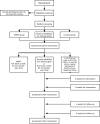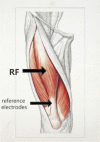Effects of whole-body vibration training on lower limb motor function and neural plasticity in patients with stroke: protocol for a randomised controlled clinical trial
- PMID: 35768103
- PMCID: PMC9240887
- DOI: 10.1136/bmjopen-2022-060796
Effects of whole-body vibration training on lower limb motor function and neural plasticity in patients with stroke: protocol for a randomised controlled clinical trial
Abstract
Introduction: Lower limb motor dysfunction is common in patients with stroke, and usually caused by brain neural connectivity disorder. Previous studies have shown that the whole-body vibration training (WBVT) significantly improves the lower limb motor function in patients with stroke and may promote nerve remodelling. The prior purpose of this study is to explore effects of WBVT on lower limb motor function and neuroplasticity in patients with stroke.
Methods: A single-blind randomised controlled trial will be conducted. Sixty patients with stroke will be recruited and allocated randomly to WBVT, routine rehabilitation training (RRT) and control group (CG). The WBVT and RRT interventions will be implemented as five 25 min sessions weekly for continuous 12 weeks; the CG will remain daily habitual living styles and routine treatments, in community or hospital, and will also receive telephone follow-up and health-related lectures. Transcranial magnetic stimulation will be used to assess neural plasticity while lower limb motor function is assessed using indicators of strength, walking ability and joint activity. The assessments will be conducted at the period of baseline, week 6, week 12 as well as on 4 and 8 weeks, respectively, after intervention completion.
Ethics and dissemination: This study has been approved by the Shanghai University of Sport Research Ethics Committee (102772021RT067) and will provide data on the effects of WBVT relative to RRT in terms of the improvement of stroke patients' lower limb motor function and neural plasticity. The results of this study will be disseminated via publications in peer-reviewed journals and presentations at international conference.
Trial registration number: ChiCTR2200055143.
Keywords: rehabilitation medicine; sports medicine; stroke.
© Author(s) (or their employer(s)) 2022. Re-use permitted under CC BY-NC. No commercial re-use. See rights and permissions. Published by BMJ.
Conflict of interest statement
Competing interests: None declared.
Figures
Similar articles
-
Combined robot motor assistance with neural circuit-based virtual reality (NeuCir-VR) lower extremity rehabilitation training in patients after stroke: a study protocol for a single-centre randomised controlled trial.BMJ Open. 2022 Dec 23;12(12):e064926. doi: 10.1136/bmjopen-2022-064926. BMJ Open. 2022. PMID: 36564112 Free PMC article.
-
Calligraphy-based rehabilitation exercise for improving the upper limb function of stroke patients: protocol for an evaluator-blinded randomised controlled trial.BMJ Open. 2022 May 13;12(5):e052046. doi: 10.1136/bmjopen-2021-052046. BMJ Open. 2022. PMID: 35568494 Free PMC article.
-
Effects of dry needling intervention on lower limb dysfunction after stroke: study protocol for a randomised controlled trial.BMJ Open. 2022 Oct 26;12(10):e062494. doi: 10.1136/bmjopen-2022-062494. BMJ Open. 2022. PMID: 36288843 Free PMC article.
-
Effect of whole-body vibration training on the recovery of lower limb function in people with stroke: a systematic review and meta-analysis.Disabil Rehabil. 2023 Nov;45(23):3823-3832. doi: 10.1080/09638288.2022.2138993. Epub 2022 Nov 11. Disabil Rehabil. 2023. PMID: 36367314
-
Effects of whole-body vibration training on physical function, activities of daily living, and quality of life in patients with stroke: a systematic review and meta-analysis.Front Physiol. 2024 Jan 23;15:1295776. doi: 10.3389/fphys.2024.1295776. eCollection 2024. Front Physiol. 2024. PMID: 38322612 Free PMC article.
Cited by
-
A Self-Coordinating Controller with Balance-Guiding Ability for Lower-Limb Rehabilitation Exoskeleton Robot.Sensors (Basel). 2023 Jun 3;23(11):5311. doi: 10.3390/s23115311. Sensors (Basel). 2023. PMID: 37300038 Free PMC article.
-
Research on the Motion Control Strategy of a Lower-Limb Exoskeleton Rehabilitation Robot Using the Twin Delayed Deep Deterministic Policy Gradient Algorithm.Sensors (Basel). 2024 Sep 17;24(18):6014. doi: 10.3390/s24186014. Sensors (Basel). 2024. PMID: 39338759 Free PMC article.
-
Low-frequency bladder vibration for the treatment of urinary tract infections in spinal cord injury patients with neurogenic bladder.Int Urol Nephrol. 2025 Jun;57(6):1689-1697. doi: 10.1007/s11255-024-04353-6. Epub 2024 Dec 30. Int Urol Nephrol. 2025. PMID: 39738856 Free PMC article. Clinical Trial.
-
Does whole-body vibration training have a positive effect on balance and walking function in patients with stroke? A meta-analysis.Front Hum Neurosci. 2023 Jan 4;16:1076665. doi: 10.3389/fnhum.2022.1076665. eCollection 2022. Front Hum Neurosci. 2023. PMID: 36684839 Free PMC article.
References
-
- Brief report on stroke prevention and treatment in China,2019. Chinese J Cerebrovasc Dis 2020:272–81. doi:CNKI:SUN:NXGB.0.2020-05-009
-
- Zhu Y. Data from: Effects of Modified Constraint-induced Movement Therapyon Walking Ability and Gait in Stroke Patients with Hemiplegic. Shanghai University of Sport, PhD dissertation, 2016.
Publication types
MeSH terms
Associated data
LinkOut - more resources
Full Text Sources
Medical


